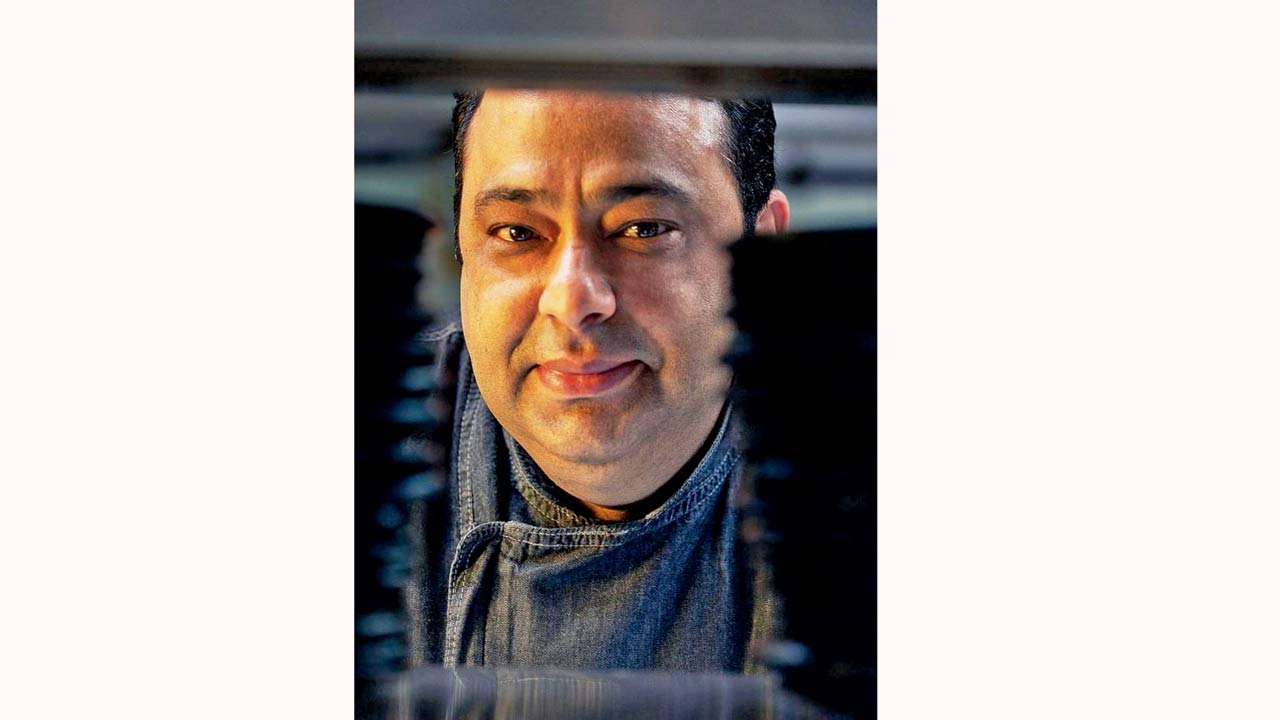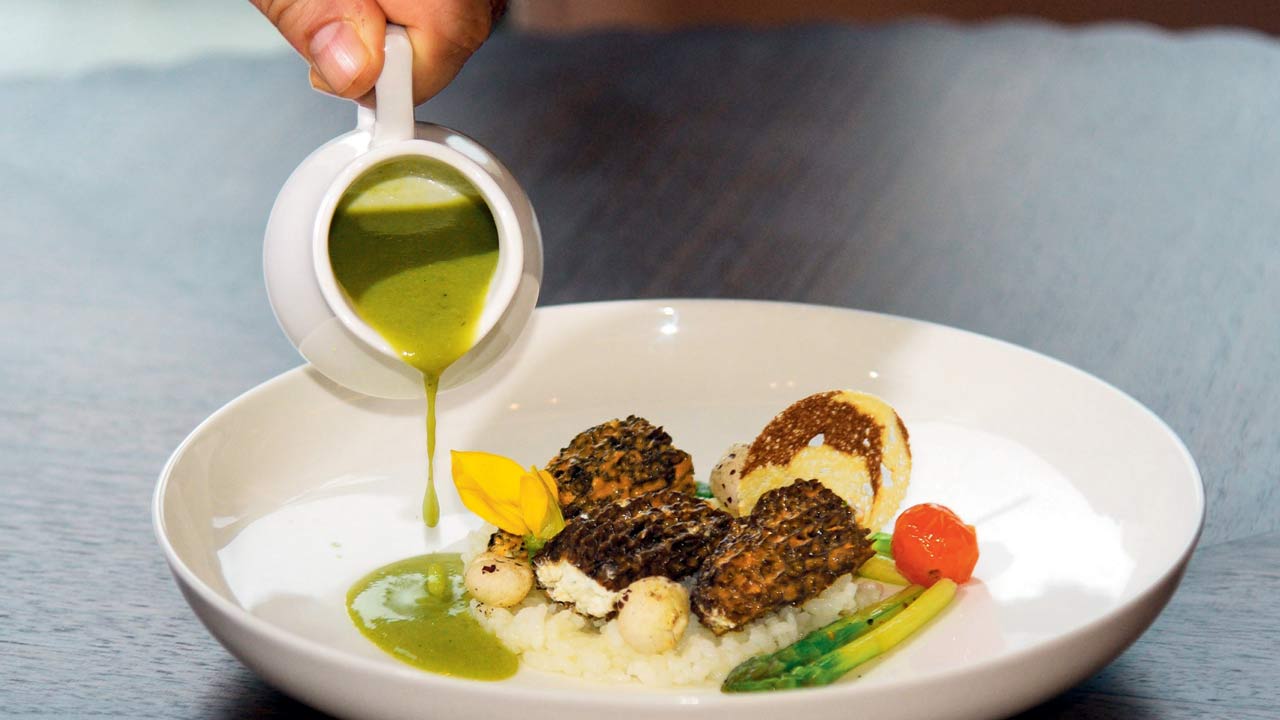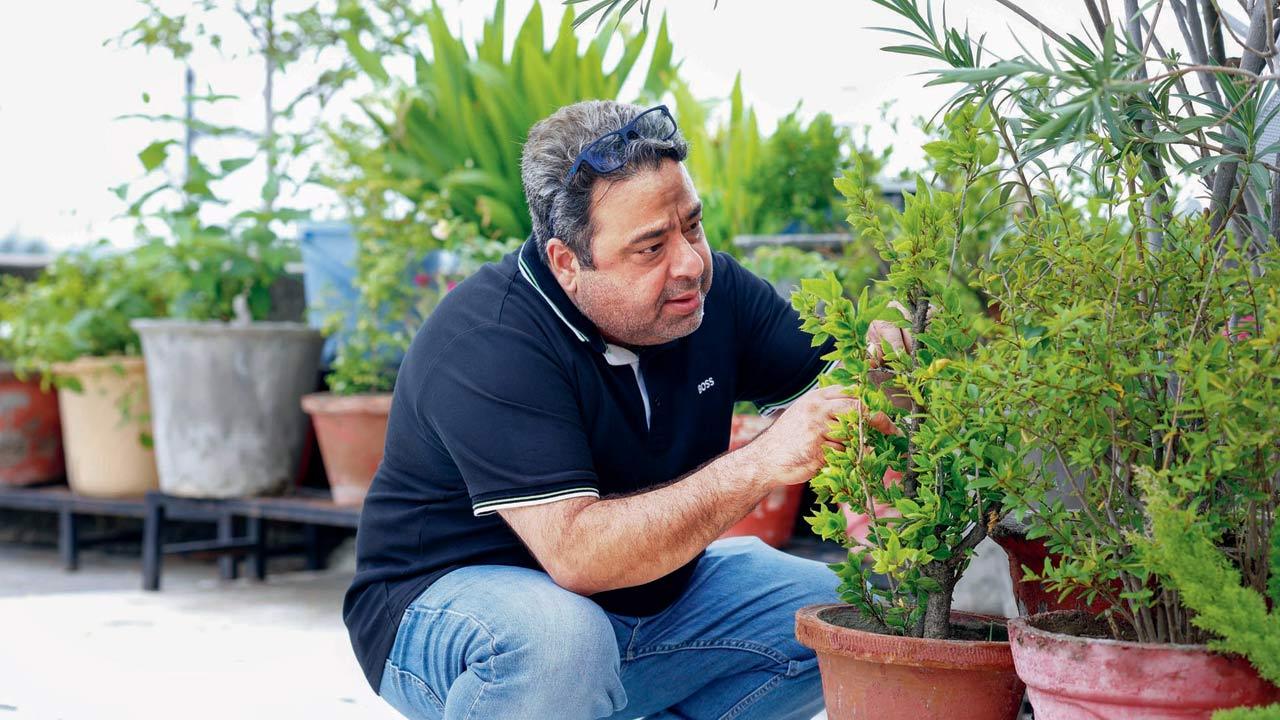After spending a lifetime redefining the nation’s cuisine for a progressive audience, Chef Manish Mehrotra leaves a culinary institution to take a break

(From left) Chef Manish Mehrotra, Rohit Khattar of Indian Accent and Chef Rijul Gulati when the restaurant launched at the Nita Ambani Cultural Centre, BKC, in July last year. File pic
 Every time we have dined at the Indian Accent, in Mumbai or Delhi, Chef Manish Mehrotra has stepped out of the kitchen to take us through the menu, and even dropped us off at the door. As if we were dining at his home. His warm hospitality is well known among the iconic restaurant’s regular patrons.
Every time we have dined at the Indian Accent, in Mumbai or Delhi, Chef Manish Mehrotra has stepped out of the kitchen to take us through the menu, and even dropped us off at the door. As if we were dining at his home. His warm hospitality is well known among the iconic restaurant’s regular patrons.
Earlier this week, Mehrotra, 50, announced his departure from the establishment that he helped transform into a global culinary landmark. Under relentless pressure to maintain its reputation and constantly innovate, Mehrotra’s efforts brought accolades and international recognition to Indian cuisine. He says he leaves Indian Accent in capable hands. This transition allows Mehrotra to explore new opportunities, focus on personal well-being, and cherish the moments he missed with family.
Your culinary journey began in Mumbai. Tell us more about it.
In 1992, after I passed Grade 12, I accompanied my elder brother to Mumbai to seek admission at Dadar Catering College [Institute of Hotel Management Catering Technology & Applied Nutrition]. My family for generations have lived in Patna, and my parents were hesitant—Mumbai had the mayanagari tag. Delhi seemed more accessible, but my brother insisted on Mumbai for this prestigious hotel management school. There was nothing like it.
I had studied in a Hindi-medium school with no big dreams. I was good in extracurricular activities, not academics. So, engineering and medicine were not options. My brother and I didn’t want to join my father’s petrol pump business. He [sibling] now runs a successful bakery and confectionery business across cities in Bihar.
When I first arrived in Mumbai, I stayed as a paying guest near Khar Gymkhana, sharing space with a Bollywood aspirant and an Iranian businessman. Six months later, I moved to the college hostel. College life was fun, and although I hadn’t decided on a kitchen career, I was happy when teachers praised my cooking and classmates sought my help. Some individuals are natural in the kitchen; others are so bad that khana jalna hi jalna hai [their food is bound to burn]! I fared well in the first practical exam and headed the kitchen team during the college fest, gradually establishing my skills.
I completed industrial training at Hyatt Regency in Delhi, where I once dropped a tray on a lady guest.
My first job was at Taj President’s Thai Pavilion under the disciplined Chef Johnson, who we learnt would sprint from Churchgate to Cuffe Parade to stay fit.
Back then, Mumbai’s Taj President was at its peak. Its restaurant were rocking: Thai Pavilion and Konkan Café... its coffee shop Trattoria had celebrities like Aamir Khan waiting at 4 am for a table. I lived in Jogeshwari East in shared accommodation, often dozing off on the train and waking up only at Goregaon. Later, we moved to the legendary Kerawala accommodation by Taj, with five people sharing a room, watching the sea, the Gateway of India, and the Radio Club with awe. There was no plug point, television or radio—but we had the best view in the city. We called it the ‘Kerawala Penthouse’.
My parents were proud—their son worked at the Taj. Sanjeev Kapoor had made the profession respectable in India. However, buying a house in Bombay was difficult. Although jobs were scarce in the capital, moving back to Delhi was more accessible. IHC called me for trials, liked my food, and that’s how my journey with Old World Hospitality began.
What was your inspiration on this journey?
I went from Delhi to London to manage the company’s restaurant; this was a game-changer. I was trained as a Pan-Asian chef; I worked with Thai and oriental cuisines. In London, I learned different techniques and gained a new perspective on cooking. I had been a frog in the well, now seeing the world. I got to work with ingredients like caviar, foie gras, scallop, and langoustine. I had only seen these in photos. This deepened my fascination with cooking.
I wasn’t a traditionally trained chef, so I approached cooking without preconceived notions. For example, I knew biryani could be cooked in a combi oven instead of on an open flame. We conducted our first trial in India without the burden of traditional methods, and everyone liked it.
Back in India, at The Manor Hotel, we wanted to start Indian Accent in November 2008. However, the 26/11 terror attack that month left the whole country in grief, and delayed our plans. We finally launched in March 2009.

And people still weren’t ready for it?
A celebrity who dined at Indian Accent remarked, “This is not an Indian Accent; this is an ‘Indian accident’.” That was disheartening…dil baith gaya [I was despondent]. But it didn’t stop us. We didn’t bow to the pressure to serve butter chicken. We started talking to the guests, explaining to them what our food was about. Occasionally, a purist would walk in and be upset that we didn’t serve their favourite kebab, korma, kaliya, and biryani, but we weren’t catering to them [anyway].
In 2012, I won a competition on a television show called Foodistan, which got me some recognition. The Manor’s location was odd—nestled in Friends Colony; people often reached Defence or New Friends Colony and called us. The colony’s gates shut early, and there was one-gate access, but people started coming and slowly understood what we were doing. With constant support from [hospitality entrepreneur] Rohit Khattar—he never pressured me to add Manchurian and chowmein—I had creative freedom. We served regular khana and pasta at our banquet parties—always on the lawns; it never appeared on the menu.
You started the awards drama and aspiration in India. What was that like?
There were no PRs, social media, no YouTube, no influencers back then; print media was king. We didn’t chase awards back in the day; there were barely a few.
The Manor had foreign guests; at one point, it was an Aman property, and they spread the word. International recognition was the turning point.
In 2013, we made it onto the Asia’s 50 Best list. I was surprised—yeh kya ho gaya?! Of the seven on the list, five [winners] were from 5-star restaurants. At one point, Indian Accent was the only one from India, with Gaggan [Anand, celebrated chef] as the only other person representing Indian cuisine. In 2015, we were listed in Time magazine, which benefited us. A piece by Tom Sietsema in The Washington Post boosted our reputation.
 Guchhi matar, asparagus and Kashmiri morel pulao at Indian Accent. File pic
Guchhi matar, asparagus and Kashmiri morel pulao at Indian Accent. File pic
What was Manish Mehrotra, the person, feeling during this phase of fame?
The pressure was immense. I was living and breathing Indian Accent. I devoted so much time to the restaurant that my home and family took a backseat.
With fame came higher expectations, and some diners who didn’t understand the cuisine would still complain—”Your restaurant has so many accolades, but you don’t serve butter chicken and papad.”
We were pioneers in India for tasting menus paired with wine, and maintaining consistency was a monumental task. Opening a restaurant is hard, but taking it to a certain level and keeping it there is a hundred times harder.
You have trained some of the best chefs in the world who went on to win Michelin stars. You didn’t get one.
I joke about it all the time. When Indian Accent became famous, our staff was poached. Some would call from the airport to say they were moving on, but we let them go with a smile. Everyone who has left the kitchen has done well for themselves. They keep in touch, and some younger talent, touch my feet when we meet. Chefs like Himanshu Saini, Saurabh Udina, Chetan Shetty, and Sanjeev Nair make me proud. They are spreading their wings. Rijul Gulati was a trainee, Shantanu Mehrotra was a management trainee. Raveesh Kapoor started as a trainee and now handles New York, and Dheeraj Dargan is at Comorin —I have scolded all of them at some point. The Indian Accent kitchen is tough. Maintaining consistency and fine dining is hard when you feed 100 tasting menus daily. Doing this on a lunch-dinner cycle is insane—add to that big weddings and catering, and the work never stops.
 Mehrotra aims to spend his retirement time by walking, eating home-cooked food, resting, and looking after the plants on his terrace. Pic/Nishad Alam
Mehrotra aims to spend his retirement time by walking, eating home-cooked food, resting, and looking after the plants on his terrace. Pic/Nishad Alam
What are your regrets?
I have many. Relatives stopped inviting us to family gatherings because I was always busy. My wife and daughter couldn’t go. Most plans were made on weekends, and I couldn’t be part of them. A restaurant requires that kind of commitment. Once it reaches a certain level, you must be on your toes, or it will falter.
Vindhya [late wife] was my most significant support. She understood this life. We met when she was training at Konkan Cafe and I was at Thai Pavilion. She was hardworking, dedicated, emotional, and passionate. She didn’t complain when I returned at 2 am or couldn’t drop our daughter to school.
She was the biggest reason I could concentrate on Indian Accent. A Tamilian from Dindigul, she lived with her family in Pune. She joined me in Delhi when we married in 2001. She was a fantastic chef who adapted quickly to my family’s UP-Bihar cooking style. My father, who never ate onion and garlic and never dined at my restaurants, loved her food because she made it with so much love.
In the last few years, she has become vegetarian but continued to make non-vegetarian dishes with the same flair for everyone.
Our daughter Adah is heading to the Culinary Institute of America this September. She is just as passionate as us; I hope this passion continues. She makes excellent food. Most days, we head to the modern bazaar and buy blue cheese, bacon, and other ingredients, and she makes a delicious pizza that we devour. She is also my greatest critic. As a single parent, I spend as much time with her as possible. We travel together, and we eat out a lot.
What does the future look like?
I have no plans at the moment. I don’t have the excuse of being busy, so I will attend all the Diwali card parties this year, celebrate Dussehra and Durga Puja, and travel more. After that, let’s see what’s in store. Whatever I do, I will do it on my terms. Indian Accent is at its peak—sales are fabulous, and the team is well-trained. The brand is in good hands. Over the last 15 years, I documented all the recipes—they know how
it works.
What’s next for the Indian cuisine?
So many ideas and concepts in the culinary world can work here [in India]. We are yet to scratch the surface, and I am not talking about vague trends. I will think, travel, and see what I can do better.
Tell us one thing your staff knows, and we don’t?
I am a huge movie buff. Unfortunately, very few good movies release these days. But my knowledge about films is desirable. I love listening to music, and I am a total newspaper person. What you get to read in a newspaper, you may not always get online. I also have a great collection of cookbooks.
I’ll get into a routine and pay attention to my health by walking, eating home-cooked food, resting, and looking after the plants on my terrace—all the things I never did. I want to do them now.
My Favourites
My favourite breakfast
Soft-boiled egg and buttered toast. I have a thing for it.
My favourite South Indian food
Pink idlis made from red rice. My mother-in-law has a recipe for them.
Favourite meal
Prawn curry with rice on a thali.
 Subscribe today by clicking the link and stay updated with the latest news!" Click here!
Subscribe today by clicking the link and stay updated with the latest news!" Click here!










